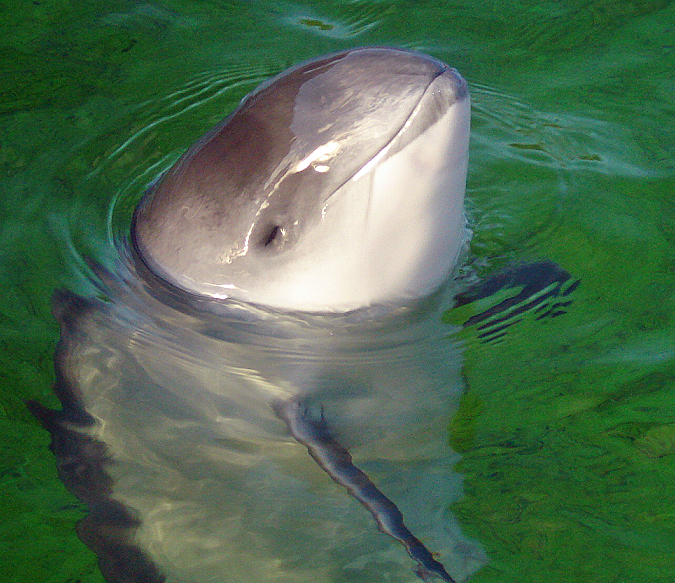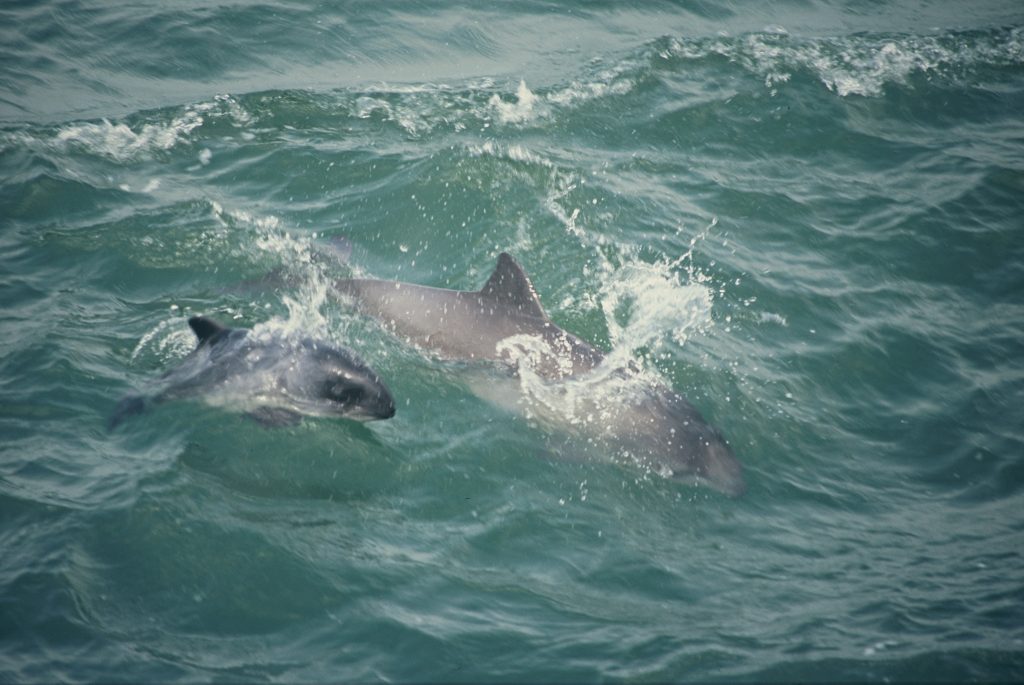The harbour porpoise Phocoena phocoena is prolific in the waters of Swansea Bay and the Gower coast but is shy and difficult to spot. Itis the smallest cetacean (family of whales and dolphins) found in European waters, measuring 1.5 metres in length and weighing about 50kg, similar to a small dolphin, but with rounder head, no beak, and a dorsal fin which shows briefly above the water. It is listed in the European Habitats Directive as a ‘vulnerable’ species, requiring protection.

North Wales Wildlife Trust describes porpoises as ‘eating machines’ as because of their small size and habitat in our chilly UK waters, they have to feed constantly to maintain their body temperature. They feed mainly on fish, including sand eels, herring and whiting. An adult porpoise will calf every 1-2 years and although few survive beyond 12 years, can live up to 20 years. The People’s Trust for Endangered Species states that the biggest threats to porpoises are:
“Accidental capture in fishing nets (they are particularly vulnerable to bottom-set nets as they forage near the seabed), pollution, declining fish stocks and hunting.”
When E.ON and DONG Energy proposed an offshore wind farm at Scarweather Sands off Porthcawl, they commissioned Chris Pierpoint to carry out an environmental survey of marine mammals potentially affected by the development.
The site proved to be one of the most important breeding grounds for the harbour porpoise in all Welsh waters, with a high incidence of mothers with calves. Scarweather would seem to be the calving site, and from here the porpoise traverse the Gower Coast and into Carmarthen Bay for social and feeding purposes.
The report subsequently produced (Pierpoint 2008, A Two Year pre-construction baseline of harbour porpoise activity at Scarweather Sands Offshore Wind Farm) is not readily accessible to the public. However, it is now one of the most important studies of porpoise in the Bristol Channel and has been championed by the former Rhossili Working Group.
The Scarweather Wind Farm did not proceed. The UK Government eventually created a number of Special Areas of Conservation for the porpoise around the UK coastline, but the waters of Swansea Bay and the Gower Coast are still not protected for the species – too many commercial interests perhaps. The area west of Carmarthen Bay which was designated instead, known as Bristol Channel Approaches, supports few porpoise because most of its sea area is too deep. This decision has been controversial!
In its 110-page document, the Inter-Agency Marine Mammal Working Group (IAMMWG 2016) looked at the responses received from two consultations about five possible Special Areas of Conservation (SAC) for harbour porpoise. The Bristol Channel Approaches and West Wales Marine were two of these five areas. For the Bristol Channel Approaches, the proposal by stakeholders was that the SAC should be extended to include Swansea Bay and the Gower coast.
key data sets have been ignored, overlooked or have not been obtained
The IAMMWG paid particular attention to issues raised by stakeholders and provided detailed responses to them. They noted that stakeholders raised concerns:
“regarding the process of analysis and identification of the best possible harbour porpoise SAC site locations, suggesting that these had not been adequately reviewed in advance of this consultation and key data sets have been ignored, overlooked or have not been obtained” [referring to three specific reports, including the one from Pierpoint in 2008][p51].
The stakeholders went on to argue that had those specific reports been considered properly, the proposed boundaries of the Special Area of Conservation would have actually extended along the South Gower coast into Swansea Bay. They also emphasised the evidence for Scarweather Sands as a location of a breeding site. The response to this argument was to reject the concerns on statistical grounds: “As the area did not meet the confidence threshold for inclusion as a summer site it was excluded from further consideration in the process.”

Carl Johnson & Maggie Kirk
Reference:
IAMMWG (2016). 2016 Consultation on possible Special Areas of Conservation for Harbour Porpoise: Post-Consultation Report. JNCC Report number 597., Peterborough. Available at: https://data.jncc.gov.uk/data/7340d052-1dd1-4165-862a-4c430d88c671/JNCC-Report-597-FINAL-WEB.pdf
Further reading
North Wales Wildlife Trust: Harbour Poprpoises
People’s Trust for Endangered Species: Harbour porpoise
